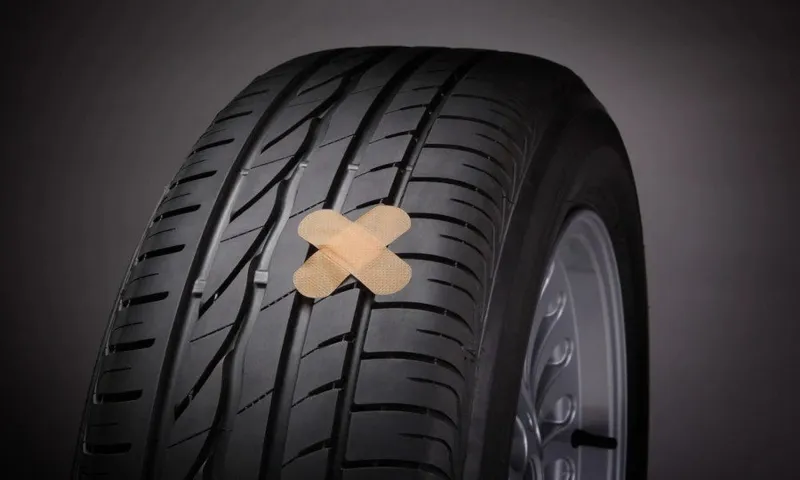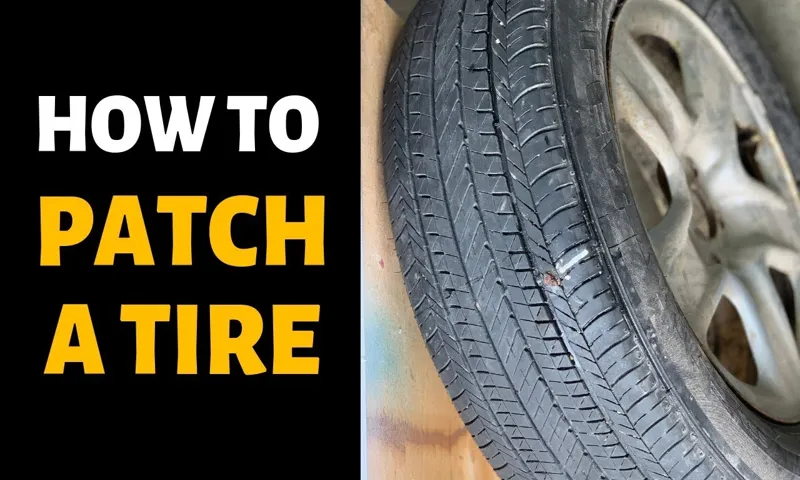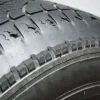Patching a tire can save you money and extend the life of your tire, but how many times can you patch a tire before it becomes unsafe? This question has been a topic of discussion for many drivers, and the answer depends on a few factors. While it may seem like a simple question, there are several variables to consider, such as the size and location of the puncture, the type of vehicle, and the type of tire. For instance, if the puncture is on the sidewall of the tire or if the tire has already been patched several times, it may not be safe to patch it again.
In this blog, we’ll dive into this common question and give you a better understanding of when and how many times you can patch your tire. We’ll explore various scenarios, including small punctures, larger punctures, and tires that have been previously patched. Additionally, we’ll discuss safety concerns and offer tips on when it’s best to replace your tire rather than patching it.
By the end of this article, you’ll have a better understanding of what to look for when it comes to tire punctures and when it’s best to consult a professional for assistance. So, buckle up, and let’s take a journey into the world of tire patching!
Table of Contents
Understanding Tire Patching
Tire patching is a common solution for repairing tires that have been damaged due to punctures or other problems. However, many people wonder how many times a tire can be patched before it needs to be replaced entirely. The answer depends on the size and location of the puncture and the condition of the tire itself.
In general, a tire can be patched up to three times, but only if the puncture is small and located in the center of the tread. If the tire has already been patched several times or if the puncture is too large or close to the sidewall, it is not safe to patch the tire again. In these cases, it is best to replace the tire altogether.
Remember, your safety on the road is of the utmost importance, so it is always better to err on the side of caution. If you’re unsure about the condition of your tire or whether it can be safely patched, consult with a professional tire technician for guidance.
Type of Tire Damage
Understanding Tire Patching – A Solution for Different Types of Tire Damage Tire damage is an inevitable part of owning a vehicle. It’s frustrating when you have to deal with it, but it’s essential to know how to patch certain tire damages to avoid unnecessary expenses. One of the most common solutions for fixing a punctured tire is patching.
However, understanding the type of tire damage is crucial in knowing whether patching is a viable option. There are different types of tire damage, and not all of them can be effectively patched. For instance, if the puncture is on the sidewall of the tire or a cut that’s too deep, patching might not be an option.
If the tire is punctured on the tread area, it’s the best type of damage for patching. Moreover, if the puncture hole is small enough, it’s advisable to patch it instead of replacing the entire tire. When patching is the preferred option, it’s essential to take it to a professional tire shop.
A tire patch requires removing the tire from the rim, inspecting the inside of the tire, and cleaning the damaged site before patching. Doing it yourself can lead to further damage, compromising the safety of the tire. In summary, understanding the type of tire damage is crucial in determining the best solution.
Patches can easily fix certain types of punctures, making it a cost-effective alternative to replacing the entire tire. However, when dealing with complex damages, it’s best to leave it to the experts. Remember, your safety on the road should always come first.

Factors Affecting Tire Patching
Tire patching is a common method of repairing punctures in tires and it can be a bit tricky to get it done just right. There are a few key factors that can affect the success of a tire patch, and understanding these factors can help you get the job done more effectively. One of the most important factors is the location and size of the puncture.
If the puncture is too large or is located in the sidewall or shoulder of the tire, it may not be possible to successfully patch the tire. Another important factor is the materials used in the patch itself. The patch should be made of high-quality materials that are designed to last, such as vulcanized rubber and high-strength adhesive.
The quality of the patchwork itself is also important, as a poorly applied patch can lead to air leaks or even a blown-out tire. Finally, it’s important to choose a patch that is suitable for the type of tire you are working on, as different types of tires require different types of patches. By taking all of these factors into account, you can ensure that your tire patching job is successful and long-lasting.
Factors Affecting Number of Tire Patches
When it comes to patching a tire, there are a few factors that can affect how many times it can be patched. The first factor is the size and location of the puncture. Small punctures in the middle of the tread can often be patched multiple times, while larger punctures near the sidewall or shoulder may only be able to be patched once or not at all.
Another factor is the age and condition of the tire. A tire that is nearing the end of its lifespan may not be able to hold a patch as well as a newer tire. Additionally, the quality of the patch and the skills of the person performing it can impact how many times a tire can be patched.
In general, it is recommended to not patch a tire more than three times for safety reasons. It is important to remember that patching a tire is not a permanent fix and it is always best to replace a tire when possible.
Tire Age and Wear
When it comes to tire age and wear, there are several factors that can affect the number of patches you need. First and foremost, the age of your tires is a crucial factor to consider. The older your tires are, the more likely they are to become damaged and punctured.
Another significant factor is the type of surface you’re driving on. If you frequently drive on rough, rocky terrain, your tires will wear down much faster than if you mainly drive on smooth roads. Furthermore, the way you drive can make a difference in your tire wear and tear.
Aggressive driving, sudden braking, and hard cornering can all lead to faster tire wear. Even the weight of your vehicle can be a factor; heavier vehicles put more pressure on the tires, causing them to wear out more quickly. Lastly, the quality of your tires is crucial for longevity and performance.
Lower-quality tires are much more likely to wear and puncture, requiring more patches. In contrast, higher-quality tires have advanced technologies that make them more resistant to wear and damage, reducing the number of patches they need. By considering these factors and choosing the right tires for your vehicle, you can help reduce the number of patches your tires need and prolong their lifespan, saving you money and improving your safety on the road.
Location of Tire Damage
When it comes to tire damage, the location of the damage plays a crucial role in determining the number of tire patches needed. Different factors can affect the number of patches required to repair a tire. For instance, the size and depth of the damage, as well as the location, can all impact the number of patches needed.
If the damage is on the outer edge of the tire or in the sidewall area, typically more patches are necessary. It’s due to the fact that these regions of the tire bear the most weight and support the car’s structure. In comparison, if the damage is towards the tire’s center or the tread area, one or two patches may suffice.
Tire damage can be risky and can lead to dangerous situations if not treated promptly. A professional tire repair service can advise on the number of patches required and repair the damage appropriately, ensuring optimal safety and performance. Remember, by seeking expert help early, you can avoid further damages and spend less in the long run.
Size of Tire Damage
The size of tire damage can significantly impact the number of patches needed to fix it. Several factors can affect the size of tire damage, including the type of terrain, the distance traveled, and the quality of the tire. For instance, rough terrain and long-distance travel can lead to larger punctures and tears in the tire, potentially requiring more patches to repair it.
The quality of the tire also plays a crucial role in its resilience to damage. High-quality tires are designed to resist punctures and cuts, while lower-end tires may be more vulnerable to damage, resulting in larger tears that require more extensive repairs. Therefore, it’s essential to choose a tire that matches your driving needs and invest in high-quality tires to minimize the risk of extensive tire damage.
When to Replace a Tire Instead of Patching
If you’re wondering how many times you can patch a tire, the answer depends on a few factors. While tire patches can be a cheaper alternative to buying new tires, it’s important to consider the safety and longevity of your vehicle. Most experts recommend not patching a tire more than three times, as too many patches can jeopardize the integrity of the tire and increase the risk of a blowout.
Additionally, if the puncture is too large or in an unsafe location, it may be more beneficial to replace the tire entirely. It’s always important to consult with a trusted mechanic or tire professional to determine the best course of action. Remember that your car’s tires are responsible for keeping it on the road, so investing in their maintenance and replacement is crucial for both safety and performance.
Safety Concerns
When it comes to safety concerns, your tires are a crucial aspect of your vehicle. But what happens when you get a puncture or a leak? Is it safe to patch it up or should you replace the tire altogether? While patching can be a quick and inexpensive solution, it’s important to know when it’s time to replace your tire instead. If the puncture is in the sidewall or shoulder of the tire, it can cause structural damage and weaken the tire’s overall integrity.
This can lead to a blowout while driving, which can be dangerous. Additionally, if the tire has been punctured multiple times or has excessive wear and tear, it’s a good idea to replace it to ensure your safety on the road. It’s best to consult with a professional mechanic who can assess the damage and provide guidance on whether to patch or replace the tire.
Your safety is paramount, so it’s important to make sure your vehicle is equipped with reliable and safe tires.
Industry Standard Guidelines
When it comes to car maintenance, tires are a hot topic. One question that often arises is whether to patch a tire or replace it altogether. While there are situations where patching may be a viable option, industry standard guidelines generally recommend replacing a tire instead.
One factor to consider is the location of the puncture. If it is on the sidewall or shoulder of the tire, patching is not recommended as it can compromise the structural integrity of the tire. Additionally, if the tire has already been patched multiple times, it may be time to replace it as the likelihood of future punctures increases.
Consider the age of the tire as well. Even if a patch seems possible, if the tire is several years old it may be nearing the end of its lifespan. Ultimately, safety should be the top priority when making the decision to patch or replace a tire.
When in doubt, consult with a trusted mechanic or refer to the manufacturer’s recommendations.
Conclusion
In short, you can patch a tire multiple times, but eventually, it will become too damaged to save. It’s like a game of Jenga, where you can keep removing and adding blocks, but eventually, the tower will topple. So, just like with Jenga, be careful not to push your luck too far and risk a blowout.
Remember: safety first, and replace the tire when it’s time.”
FAQs
1. How long can a patch on a tire last before needing a replacement? – A patch on a tire can last for the life of the tire if it was done correctly and the tire was in good condition before the patch was applied. 2. Is it safe to patch a tire multiple times? – It is generally not recommended to patch a tire more than once as each patch weakens the tire. However, if the puncture is small and in a different location from any previous patches, it may be possible to patch it again. 3. Can I patch a sidewall puncture on my tire? – No, sidewall punctures cannot be patched. The sidewall is a crucial and delicate part of the tire, and any damage to it requires the tire to be replaced. 4. How much does it cost to patch a tire? – The cost of patching a tire typically ranges from $10 to $30, depending on the type of tire and severity of the damage. It is often cheaper than buying a whole new tire. 5. When should I consider replacing my tire instead of patching it? – If the puncture is larger than 1/4 inch, the tire is older than 5 years, or if there is any sidewall damage, it is usually recommended to replace the tire instead of patching it. 6. Can a patched tire affect the overall performance of my car? – A properly patched tire should not affect the overall performance of the car. However, if the tire is not balanced or aligned properly after patching, it may cause vibrations or uneven wear. 7. Do all tire shops offer tire patching services? – Most tire shops offer tire patching services, but it is important to make sure that the shop you choose has certified technicians and uses high-quality equipment and materials.



